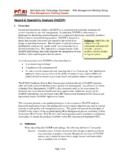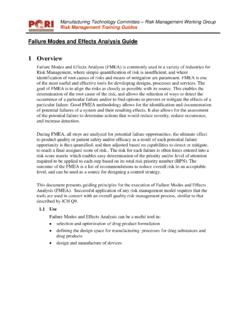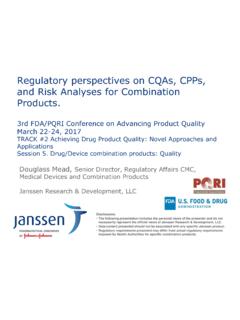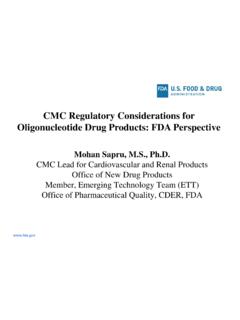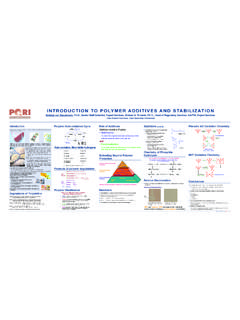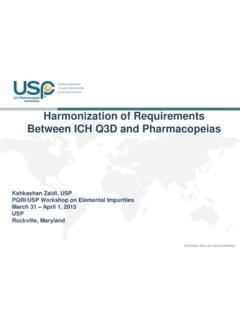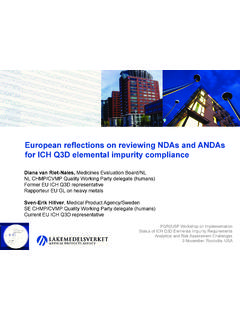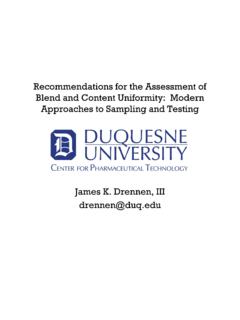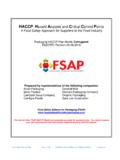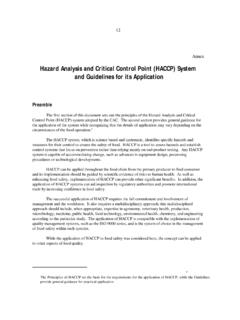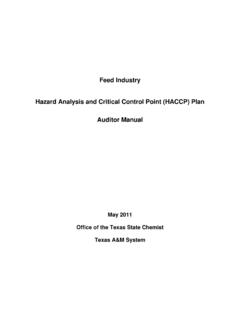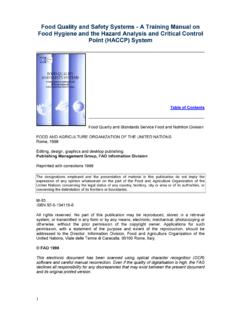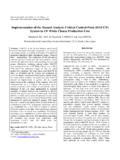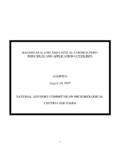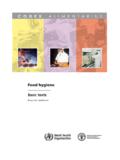Transcription of Hazard Analysis and Critical Control Points Guide - PQRI
1 Manufacturing Technology Committee Risk Management Working Group Risk Management Training Guides Hazard Analysis and Critical Control Points (HACCP) Page 1 of 8 1 Overview Hazard Analysis and Critical Control Point (HACCP) has been defined by the World Health Organization as a scientific, rational and systematic approach for the identification, assessment and Control of Originally developed to focus on food safety hazards , the HACCP system has been successfully applied to other applications and other industries. The intent of HACCP is to help prevent known hazards and to reduce the risks that they will occur at any point in a process through the execution of seven core action: 1.
2 Conduct a Hazard Analysis 2. Determine the Critical Control Points (CCPs) 3. Establish Target Levels and Critical Limits 4. Establish System(s) to monitoring CCPs 5. Establish an appropriate Corrective Action Plan for each CCP. 6. Establish Procedures to verify that the HACCP system is working effectively 7. Establish Documentation concerning all procedures and keep records of their application. Because the approach enforces procedural governance and rigorous documentation practices, HACCP serves not only as a model to assess risk, but also as an effective means to communicate risk Control . This document presents some core steps in the execution of HACCP. Successful application of any risk management model requires that tools are used in concert with the quality risk management process.
3 This Guide will present the seven principles of HACCP in the context of the ICH Q9 defined quality risk management process consisting of Risk Assessment, Risk Control , Risk Review and Communication. Usage The Hazard Analysis and Critical Control Point (HACCP) System: Is focused on safety hazards typical safety hazards include biological, chemical or physical agents or operations that could lead to illness or injury if not controlled Typically, includes an entire process ( , for pharmaceutical manufacturing, it typically encompasses raw material receipt through distribution to the consumer) Is implemented through a plan that details the initial Analysis and the on-going monitoring and review.
4 The Plan is a living system; not a one-time assessment. Generates a HACCP Control Chart listing the potential hazards , preventive measures, Critical limits, monitoring systems and corrective actions associated with each Critical Control Point. 1 HACCP: Introducing the Hazard Analysis and Critical Control Point System, World Health Organization, 1997 Background: HACCP was conceived by NASA, the Army Laboratories at Natick and the Pillsbury Company as a means to ensure the safety of food consumed by NASA astronauts. Training Guide : Hazard Analysis and Critical Control Points (HACCP) Page 2 of 8 Advantages Disadvantages + Output is easy to understand useful for communication + Fosters holistic and comprehensive understanding of hazards and controls for a process + Emphasis on Control not detection - Requires comprehensive process understanding not ideally suited for little known hazards or processes - Does not quantify or prioritize risks - Does not quantify impact of additional controls on reducing risk Quality Risk Management Applications HACCP is well-suited for a variety of applications, including.
5 To identify microbiological hazards and their controls in a process As an input to define Critical Process Parameters and the associated action and alert limits for those parameters As a structure to evaluate, support and communicate the effectiveness of cleaning and sanitization processes To evaluate the impact of operator actions on the quality and safety of a product. 2 Preliminary Tasks Define Risk Question and Scope of System The first step in any risk management effort is to define the overall risk question. Answering the risk question represents the ultimate goal of the risk assessment. Examples of risk questions include: How often should a manufacturing site be audited to assure GMP compliance?
6 What root causes of non-conformances should we prioritize for remediation? What are the appropriate back-up inactivation methods that provide an appropriate level of decontamination in a fermentation suite to inactivate BL2 waste and equipment when the inactivation autoclave is unavailable? Assemble the HACCP Team and Define Scope Because of the complexity and variety of potential hazards with any pharmaceutical product or process, it is important to assemble a multidisciplinary HACCP team. The scope of the effort will indicate the type and level of expertise of required HACCP team members. For example, for an effort focused on patient or consumer safety concerns, a HACCP team should have available expertise in: Active ingredients and associated impurities and degradants Operations, including synthesis, manufacturing and packaging processes Utilities, including water systems, HVAC and electrical Cleaning processes, including detergents and sanitizing agents Process changeovers, including manual operations such as clearance practices and equipment assembly / disassembly Microbiological flora inherent in raw materials, products or the environment Training Guide .
7 Hazard Analysis and Critical Control Points (HACCP) Page 3 of 8 Product characteristics that may impact stability of the product, including packaging materials of construction, closures, and physical product robustness Handling of a product by the patient, consumer or caregiver, including potential misuse, including implications of label comprehension, storage, and possible off-label use Health implications of exposure or consumption of hazards , including concomitant medications If the scope of the initiative includes operator safety or environmental impact, the team should also be represented by an expert in safety and industrial hygiene. As with any project, the scope should be clearly defined as part of chartering the initiative.
8 Clearly-defined boundaries will help ensure that suitable team members are selected, representation, realistic goals are set, and that management and the HACCP team members are aligned and committed. Describe the Product, Intended Use and Process The HACCP team should first define the product(s) associated with the HACCP System. Because each product has a unique set of process steps and associated hazards , it is important that all products are defined through physical, chemical and biological characteristics. It is also important to consider the intended use of a product. If a product requires another device or another component as part of administration or use by the patient or consumer, it will be necessary to identify the hazards associated with that process.
9 At this early stage in the HACCP initiative, it may be helpful to group products by their characteristics, or by their intended use. Grouping helps to consolidate the assessment and management of risks and streamline the effort. Grouping can be done if the processes and intended use of a set of products are consistent. In cases where variations exist, the HACCP team may still choose to group products and assume the worst-case based on scientific rationale It is at this point that the HACCP team will define the process. The process should be sufficiently detailed to highlight hazards and Control Points . It should depict: Process steps and equipment, whether manual or automated Direct process Control elements, including on-line instrumentation, logic, manufacturing procedures and testing and inspection controls Indirect process controls including operator gowning, maintenance, cleaning and storage Quality controls supporting raw material and finished product release.
10 As with products, the HACCP team may choose to group similar process elements to simplify the effort. Tip: It is said that there are typically three different versions of a process: 1. What the SOP describes 2. What operators normally do 3. What operators do during both normal and abnormal conditions Unless your process flow encompasses the third version, you may be missing Critical steps. Training Guide : Hazard Analysis and Critical Control Points (HACCP) Page 4 of 8 Challenge, Refine and Confirm the Process Flow Once the process flow has been defined, it is important for the HACCP team to review the process with operators and/or other process experts and challenge the steps to confirm accuracy and completeness.
